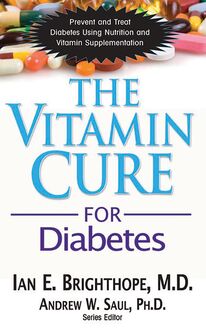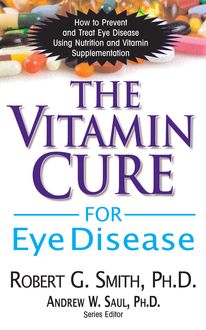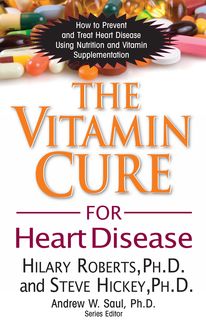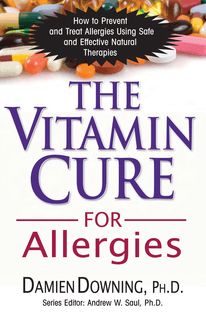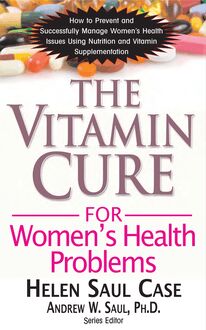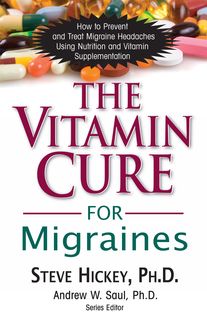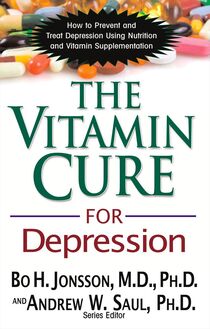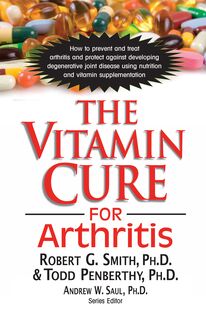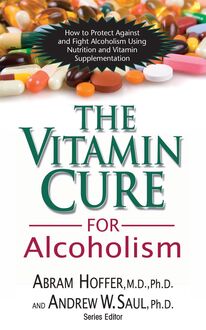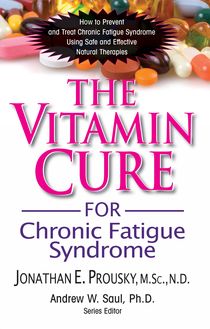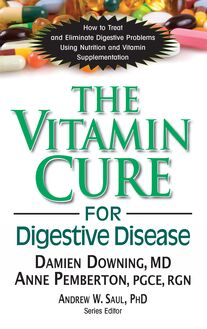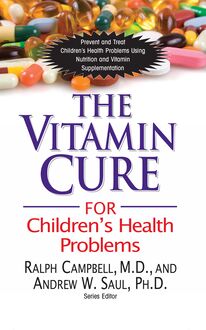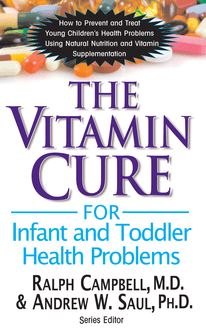The Vitamin Cure for Migraines , livre ebook
110
pages
English
Ebooks
2010
Vous pourrez modifier la taille du texte de cet ouvrage
Obtenez un accès à la bibliothèque pour le consulter en ligne En savoir plus
Découvre YouScribe en t'inscrivant gratuitement
Découvre YouScribe en t'inscrivant gratuitement
110
pages
English
Ebooks
2010
Vous pourrez modifier la taille du texte de cet ouvrage
Obtenez un accès à la bibliothèque pour le consulter en ligne En savoir plus
Publié par
Date de parution
01 juin 2010
Nombre de lectures
3
EAN13
9781591203285
Langue
English
Publié par
Date de parution
01 juin 2010
Nombre de lectures
3
EAN13
9781591203285
Langue
English
THE
V ITAMIN
C URE
for Migraines
S TEVE H ICKEY , P H .D.
The information contained in this book is based upon the research and personal and professional experiences of the author. It is not intended as a substitute for consulting with your physician or other healthcare provider. Any attempt to diagnose and treat an illness should be done under the direction of a healthcare professional.
The publisher does not advocate the use of any particular healthcare protocol but believes the information in this book should be available to the public. The publisher and author are not responsible for any adverse effects or consequences resulting from the use of the suggestions, preparations, or procedures discussed in this book. Should the reader have any questions concerning the appropriateness of any procedures or preparation mentioned, the author and the publisher strongly suggest consulting a professional healthcare advisor.
Basic Health Publications, Inc.
28812 Top of the World Drive
Laguna Beach, CA 92651
949-715-7327 • www.basichealthpub.com
Library of Congress Cataloging-in-Publication Data
Hickey, Steve
The vitamin cure for migraines / Steve Hickey.
p. cm.
Includes bibliographical references and index.
ISBN 978-1-59120-267-7
1. Migraine. 2. Orthomolecular therapy. I. Title.
RC392.H525 2010
616.8'491206—dc22
2009044167
Copyright © 2010 by Steve Hickey, Ph.D.
All rights reserved. No part of this publication may be reproduced, stored in a retrieval system, or transmitted, in any form or by any means, electronic, mechanical, photocopying, recording, or otherwise, without the prior written consent of the copyright owner.
Editor: John Anderson
Typesetting/Book design: Gary A. Rosenberg
Cover design: Mike Stromberg
Printed in the United States of America
10 9 8 7 6 5 4 3 2 1
C ONTENTS
Acknowledgments
Introduction
CHAPTER 1: The Migraine Experience
CHAPTER 2: A Search for Causes
CHAPTER 3: Diagnosing a Migraine
CHAPTER 4: Avoid Junk Food
CHAPTER 5: Preventing a Migraine with Nutrition
CHAPTER 6: Supportive Nutrition
CHAPTER 7: Stopping an Attack
CHAPTER 8: Physical Therapies for Migraines
CHAPTER 9: Get Your Life Back
Conclusion
References
About the Author
A CKNOWLEDGMENTS
An author producing a book on such a complex topic with a reasonable level of readability must rely on the help and support of others. This book depended on the expert assistance of Dr. Hilary Roberts, who read the manuscript, made suggestions, and corrected errors. Other critical reviewers included Andrew Hickey and Holly Matthies, who also suffer migraines. Dr. Damien Downing, president of the British Society for Ecological Medicine, provided me with information about migraines and various supplements. Dr. Abram Hoffer was gracious in responding to my e-mail questions. I am also grateful to Dr. Claus Hanke for his discussion of the role of orthomolecular medicine in normal medical practice. Dr. Gert Suitemaker and Elsedien de Groot from time to time provided helpful advice from their extensive knowledge of nutrition. Meleni Aldridge and Dr. Rob Verkerk continue to be supportive in promoting the role of nutrition in migraine and other aspects of health care.
This book would not exist without Andrew Saul, editor of The Vitamin Cure series, who was aware of my history of migraines and decided to aggravate the condition by suggesting I write about them. I accepted the challenge, as an opportunity to delve more closely into the underlying causes of migraine. For about three decades, I have been trying different remedies, some more effective than others, and writing this book allowed an intensified series of personal trials, along with the associated suffering and resultant findings.
I NTRODUCTION
If I wished to show a student the difficulties of practice, I should give him a headache to treat.
—O LIVER W ENDELL H OLMES (1809-1894)
A s anyone who suffers from migraines knows only too well, they can occur at the most inconvenient times. A short time ago, I was standing on a podium at a medical convention, before 300 or so delegates, including world-renowned scientists and doctors. My talk was controversial and certain members of the audience might be eager to take advantage of any errors I might make. Normally, I would relish such a challenge, but this time I had a migraine.
That morning, I had awakened around five o’clock, with a severe pounding in the left side of my head. People don’t normally sleep through a migraine—some call it the “alarm clock headache,” as the pain is too intense to sleep. The veins in my head felt as though they contained battery acid rather than blood, and my skull seemed to expand and shrink with every heartbeat. Attempting to ease the agony, I took a cocktail of drugs aimed at aborting the migraine, but they had no effect. I then took a selection of painkillers to allow myself just to function. The result was a slight dulling of the pain and a substantial numbing of my faculties. For the next four hours, I sat in a darkened room with my head wrapped in ice, with psychedelic colors and the high-pitched whine of tinnitus for company.
Although migraine pain is brutal, it was not my only problem. Once in the conference room, I exhibited the first slide of my talk and wondered whether I would find I was anomic. Anomia is the inability to remember nouns (the words used as names and labels). It is an atypical symptom of migraine, but happens to me often enough that I compensate for it in advance by putting essential words on the slides. My brain felt sluggish and the room seemed to darken, producing tunnel vision. Unfortunately, when the first slide appeared on the computer monitor, my vision was blurred—I could see two of everything and the text was unreadable. Turning my head to view the image projected for the audience, the glare from the screen increased my pain dramatically. However, at least I could read the words.
Looking into the darkened room, patches of color flooded my visual field, similar to effects reported for hallucinogenic drugs, and my ears continued to ring with high-pitched noise. From experience, I knew that I would need to avoid simple arithmetic calculations (paradoxically, complex logical and mathematical relations would be fine). Keep your sentences short and simple, I told myself. My left thumb started an involuntary twitch, so I had to use my right hand to change the slides. The urge to vomit had passed, but I felt dizzy and lightheaded. Apparently, I delivered my presentation in an acceptable manner, though, to be honest, I recall little about it.
Migraines can occur frequently and I have had many. My first, at the age of ten, was on a bus trip to Blackpool, a coastal resort in England. My mother told me I had travel sickness. For years, physicians told me my problems were caused by sinusitis. Eventually, I diagnosed my condition for myself. One of my reasons for writing this book was the opportunity to review medical progress on migraine and its treatment. In the process, I hoped I would find ways of reducing the number and severity of my own attacks. I am happy to report that I have managed to lower the intensity and frequency of my major headaches. Readers can have a reasonable expectation of similar benefit.
A MAJOR DISABILITY
Migraine is a major disability and one of the most incapacitating diseases. This book addresses the illness and provides an effective nutritional approach to treatment. Though painful, migraine and headache do not significantly increase the risk of death. Because of this, many people (medical professionals included) do not appreciate the seriousness of the condition. 1 Headache, and especially migraines, are major health problems, devastating people’s lives and damaging the economy.
Almost half the population suffer from headaches. Migraine attacks interfere with employment, undermining the sufferer’s career and financial prospects, as well as restricting family and social life. Migraineurs live in constant fear of the next attack. 2 Taking all causes of disease and disability into consideration, migraine is high on the list of conditions that take away useful years of a person’s life. The World Health Organization (WHO) ranks headache as one of the ten most destructive conditions in terms of useful days lost. 3 Migraines specifically are ranked by the WHO as the nineteenth most devastating condition in terms of days lost to illness. 4 Since headaches are most common between the late teens and sixty years of age, there is a consequent loss to the economy and society 5 ; about 25 million working or study days are lost to migraine each year in the United Kingdom alone. 6
The pathologies of migraine and headache are difficult to study scientifically because of the complexity of investigating what is going on inside the brain and its surrounding tissues. However, recent research holds out the promise that developments in prevention and therapy may arise soon. Readers who are disabled by headaches can have reasonable expectations that their illness may be managed and they can get their lives back. This book aims to help people suffering from migraine headaches to reclaim time lost to this condition. While a cure for migraine is elusive, with appropriate nutritional support, sufferers’ lives can be greatly improved.
THE LIMITS OF THE CONVENTIONAL APPROACH
Until recently, our understanding of migraines was misdirected. For centuries, it was considered a disease of the blood vessels. Later, doctors claimed it was related to levels of serotonin, the “happiness neurotransmitter” in the brain. More recently, migraine has been proposed to originate in the cortex of the brain, the brain stem, and the nerves that supply the face and head. Notwithstanding changes in understanding the underlying mechanisms, therapies based on earlier models have had some limited degree of succe
